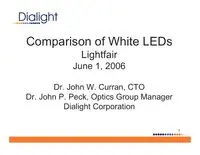
Lightfair Presentation 6-1-06 2006 PDF
Preview Lightfair Presentation 6-1-06 2006
1 Comparison of White LEDs Lightfair June 1, 2006 Dr. John W. Curran, CTO Dr. John P. Peck, Optics Group Manager Dialight Corporation 2 White Through History Limelight - the first solid-state lighting device (introduced by Thomas Drummond in 1826) Cylinder of lime (calcium oxide) which is heated to a state of dazzling brilliancy by the flame of the oxy-hydrogen blowpipe 3 Course Outline Introduction Background Terminology Flux Color - Measuring Color - White Forward Voltage, Vf LED construction General White Lifetime Discussion Design Guidelines Thermal Issues Differences in data sheet vs actual flux values Manufacturer’s Data Specifications [Cool White] Specifications [Warm White] Binning Test Results Spectral Data Chromaticity Data CCT Luminous Flux Data Trends Conclusions Questions 4 Objectives of the Course • White LED Technology – Types of white LEDs – How do they work • Design Advantages of the Technology – Life – Efficiency • Design Considerations – Color matching – Heat dissipation – Cost • Range of Products Available Today 5 White Through History Progress in lighting 6 Progression of White Lighting 7 Specifying LEDs (in general) • Type (3mm, 5mm, High Flux, etc.) • Flux • Color • Forward Voltage 8 Definitions - Flux Photometric (Lighting) Terms • Standard Candle—a candle which emits uniform luminous intensity in all directions of one candlepower • Lumen—rate at which luminous flux falls on a one foot square surface of a unit sphere from a uniform source of one candela located at the center of the sphere. The standard candle emits 4π lumens • Luminous Energy (Q)—term used to describe luminous power Q (in lumen-seconds, lm-sec) • Luminous Flux (φ)—rate of flow of luminous energy given by φ = dQ / dt (in lumens, lm) • Luminous Intensity (I)—is the luminous flux divided by the solid angle in a specific direction given by I = dφ / dω (in candelas, cd) • Solid Angle (ω)—is the ratio of the area A of a sphere to the square of the radius r ω = A / r2 (in steradians, sr) • Illumination (E)—is the incident luminous flux (φ) per unit area of the receiving surface E = dφ / dA (in footcandles, fc) 9 Definitions - Flux Radiometric (Physics) Terms • Radiant Energy (U)—term used to describe energy emitted by a light source U (in joules) • Radiant Flux (Φe)—rate of flow of radiant energy given by Φe = dU / dt (in watts) • Radiant Intensity (Ie)—is the radiant flux divided by the solid angle in a specific direction given by Ie = dΦe / dω (in watts/steradian) • Spectral Power Distribution or SPD (Φeλ)—is the spectral density of the radiant flux given by Φeλ = dΦe / dλ (in watts/meter) • Solid Angle (ω)—is the ratio of the area A of a sphere to the square of the radius r ω = A / r2 (in steradians, sr) • Illumination (E)—is the incident luminous flux (φ) per unit area of the receiving surface E = dφ / dA (in footcandles, fc) 10 Definitions - Flux How the two worlds relate φeλ = 683 lm/watt ∫ Φeλ V(λ) dλ Eye Response Curves 0.0 0.1 0.2 0.3 0.4 0.5 0.6 0.7 0.8 0.9 1.0 350 400 450 500 550 600 650 700 750 Wavelength (in nm) Relative Reponse Photopic Response Scotopic Response 11 Definitions—Flux Radiometric Flux to Luminous Flux 0 0.1 0.2 0.3 0.4 0.5 0.6 0.7 0.8 0.9 1 400 450 500 550 600 650 700 Wavelength (nm) Photopic Eye Response 12 Definitions - Color X, Y and Z are the spectral response curves for the three different cone receptors in the eye. If the eye response to a color stimulus is given by X, Y and Z, we can define a color coordinate system as the relative stimulus given by the following equations: ________ ________ ________ With X + Y + Z = 1 by definition only two coordinates are necessary to define a color. X = X y = z = Y Z X + Y + Z X + Y + Z X + Y + Z Spectral Response CIE Chart 13 Definitions - Color White LED Range 14 Definitions—Color Chromaticity Comparison 0.2 0.25 0.3 0.35 0.4 0.45 0.5 0.2 0.25 0.3 0.35 0.4 0.45 0.5 0.55 0.6 x y Osram Cool Osram Warm Lumileds Cool Lumileds Warm Nichia Cool Nichia Warm Cree XL Cree XR Seoul Cool Seoul Warm Cotco Cool Blackbody 15000 Kelvin 2500 Kelvin 15 Measuring Color Color Rendering Index (CRI) CRI is a calculated value based on the difference in chromaticity of a series of 8 different colors (CIE Color Space) when illuminated with a reference light source versus a test subject light source. It is a measure of a light source’s ability to show colors realistically as compared to familiar sources (e.g. an incandescent bulb or the sun)
